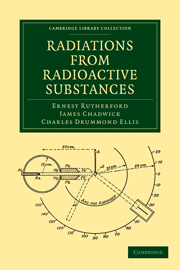Book contents
- Frontmatter
- Contents
- LIST OF PLATES
- Preface
- Chap. I Radioactive Transformations
- Chap. II The α Rays
- Chap. III Absorption of the α Rays
- Chap. IV Some Properties of the α Particle
- Chap. V Theories of Absorption of α Rays
- Chap. VI Secondary Effects produced by α Rays
- Chap. VII General Properties of the Radiations
- Chap. VIII The Scattering of α and β Particles
- Chap. IX The Collisions of α Particles with Light Atoms
- Chap. X The Artificial Disintegration of the Light Elements
- Chap. XI The Radioactive Nuclei
- Chap. XII β Ray and γ Ray Spectra
- Chap. XIII The Disintegration Electrons
- Chap. XIV The Passage of β Particles through Matter
- Chap. XV The Scattering and Absorption of γ Rays
- Chap. XVI Intensity Problems connected with the Emission of γ Rays
- Chap. XVII Atomic Nuclei
- Chap. XVIII Miscellaneous
- Appendix
- Subject Index
- Index of Names
- Plate section
Chap. VIII - The Scattering of α and β Particles
Published online by Cambridge University Press: 07 September 2010
- Frontmatter
- Contents
- LIST OF PLATES
- Preface
- Chap. I Radioactive Transformations
- Chap. II The α Rays
- Chap. III Absorption of the α Rays
- Chap. IV Some Properties of the α Particle
- Chap. V Theories of Absorption of α Rays
- Chap. VI Secondary Effects produced by α Rays
- Chap. VII General Properties of the Radiations
- Chap. VIII The Scattering of α and β Particles
- Chap. IX The Collisions of α Particles with Light Atoms
- Chap. X The Artificial Disintegration of the Light Elements
- Chap. XI The Radioactive Nuclei
- Chap. XII β Ray and γ Ray Spectra
- Chap. XIII The Disintegration Electrons
- Chap. XIV The Passage of β Particles through Matter
- Chap. XV The Scattering and Absorption of γ Rays
- Chap. XVI Intensity Problems connected with the Emission of γ Rays
- Chap. XVII Atomic Nuclei
- Chap. XVIII Miscellaneous
- Appendix
- Subject Index
- Index of Names
- Plate section
Summary
§ 42. The scattering of α particles and the nuclear theory of the atom. When α particles pass through matter, some of them are deviated from their original direction of motion and undergo the process known as scattering. The presence of this scattering was first shown by Rutherford by a photographic method. He found that the image of a narrow slit produced by a beam of α particles had sharply defined edges when the experiment was performed in an evacuated vessel. If air was admitted into the apparatus, or if the slit was covered with a thin sheet of matter, the photographic trace of the pencil of α rays was broadened and the intensity of the photographic effect faded off slowly on either side of the centre.
A detailed examination of the amount and character of the scattering of the α particles in passing through matter was first made by Geiger, using the scintillation method of detecting the particles. These experiments will be described later. It will be sufficient to say here that they showed that the scattering suffered by α particles in penetrating the atoms of matter is relatively very small. The average angle of scattering even by comparatively thick sheets of matter was only a few degrees. About the same time Geiger and Marsden made the very striking observation that some of the α particles in a beam incident on a sheet of matter have their directions changed to such an extent that they emerge again on the side of incidence, that is, they are deflected through angles greater than 90°.
- Type
- Chapter
- Information
- Radiations from Radioactive Substances , pp. 191 - 239Publisher: Cambridge University PressPrint publication year: 2010First published in: 1930



